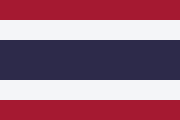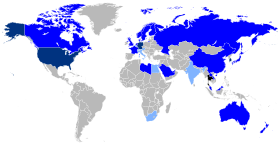
Back Thai (volk) Afrikaans تايلانديون Arabic تايلانديين ARZ Таи Bulgarian Tailandesos Catalan Thajci Czech Thai (Ethnie) German Tajoj Esperanto Tailandeses Spanish Tailased Estonian
 | |
 Thai people at a cremation ceremony at Wat Chedi Luang in Chiang Mai | |
| Total population | |
c. 52–59 million[a]
 | |
| Regions with significant populations | |
| Thailand c. 51–57.8 million[nb 1][1][2][3] | |
| c. 1.1 million | |
| 319,794[4] (2017) | |
| 185,389[5] (2018) | |
| 115,000[6] (2020) | |
| 81,850[7] (2019) | |
| 64,922[8] (2018) | |
| 61,771 (December 2023)[9] | |
| 51,000–70,000[10][11] (2012) | |
| 47,700[10] (2012) | |
| 45,000[12] (2018) | |
| 44,339[13] (2019) | |
| 30,000 (2012)[10] | |
| 28,000[10] (2011) | |
| 24,600[10] (2011) | |
| 24,000[14] (2020) | |
| 22,275[15] (2021) | |
| 22,194[16] (2020) | |
| 20,106 (2017)[17] | |
| 15,497[18] (2015) | |
| 14,232[10] (2012) | |
| 14,087[19] (2015) | |
| 13,687[20] (2019) | |
| 12,952 (2019)[21] | |
| 12,947[22] (2020) | |
| 11,493[23] (2016) | |
| 11,240[10] (2012) | |
| 10,251 (born), c. 50,000 (ancestry)[24] (2018) | |
| 9,058[25] (2015) | |
| 8,618[10] (2012) | |
| 5,766[26] (2016) | |
| 5,466[10] (2012) | |
| 3,773[10] (2012) | |
| 3,715[10] (2012) | |
| 3,500[10] (2012) | |
| 2,500[10] (2012) | |
| 2,424[10] (2012) | |
| 2,378[10] (2012) | |
| 2,331[10] (2012) | |
| 2,051[27] (2022) | |
| Rest of the world | c. 47,000[28] |
| Languages | |
| Central Thai, Southern Thai | |
| Religion | |
| Predominantly : Theravada Buddhism 97.6% Minorities: Islam 1.6% | |
| Related ethnic groups | |
| |

Thai people (Thai: ชาวไทย; endonym), Chao Phraya Thai (Thai: ไทยลุ่มเจ้าพระยา; exonym and also academic),[b] Central Thai people (Thai: คนภาคกลาง; exonym and also domestically),[b] Southern Thai people (Southern Thai: คนใต้; exonym and also domestically),[b] Siamese, Thai Siam (Thai: ไทยสยาม; historical exonym and sometimes domestically),[b] Tai Noi people (Thai: ไทน้อย; historical endonym and sometimes domestically), are a Southeast Asian ethnic group native to Thailand. In a narrower sense, the Thais are also a Tai ethnic group dominant in Central and Southern Thailand (Siam proper).[29][30][31][32][33][2][34] Part of the larger Tai ethno-linguistic group native to Southeast Asia as well as Southern China and Northeast India, Thais speak the Sukhothai languages (Central Thai and Southern Thai language),[35] which is classified as part of the Kra–Dai family of languages. The majority of Thais are followers of Theravada Buddhism.
Government policies during the late 1930s and early 1940s resulted in the successful forced assimilation of various ethno-linguistic groups into the country's dominant Central Thai language and culture, leading to the term Thai people to come to refer to the population of Thailand overall. This includes other subgroups of the Tai ethno-linguistic group, such as the Yuan people and the Isan people, as well as non-Southeast Asian and non-Tai groups, the largest of which is that of the Han Chinese, who form a substantial minority ethnic group in Thailand.
Cite error: There are <ref group=lower-alpha> tags or {{efn}} templates on this page, but the references will not show without a {{reflist|group=lower-alpha}} template or {{notelist}} template (see the help page).
Cite error: There are <ref group=nb> tags on this page, but the references will not show without a {{reflist|group=nb}} template (see the help page).
- ^ McCargo, D.; Hongladarom, K. (2004). "Contesting Isan-ness: Discourses of politics and identity in Northeast Thailand" (PDF). Asian Ethnicity. 5 (2): 219. doi:10.1080/1463136042000221898. S2CID 30108605. Archived from the original (PDF) on 2017-08-09. Retrieved 2016-09-03.
- ^ a b David Levinson (1998), Ethnic Groups Worldwide: A Ready Reference Handbook, Oryx Pres, p. 287, ISBN 978-1-57356-019-1
- ^ Paul, Lewis M.; Simons, Gary F.; Fennig, Charles D. (2013), Ethnologue: Languages of the World, SIL International, ISBN 978-1-55671-216-6
- ^ "ASIAN ALONE OR IN ANY COMBINATION BY SELECTED GROUPS". factfinder.census.gov. Archived from the original on 14 February 2020. Retrieved 2 May 2019.
- ^ "출입국·외국인정책 내부용 통계월보 (2018년 7월호)" (PDF). gov.kr (in Korean). Retrieved 2 May 2019.
- ^ "Bevölkerung in Privathaushalten nach Migrationshintergrund im weiteren Sinn nach Geburtsstaat in Staatengruppen".
- ^ "Estimated resident population, Country of birth - as at 30 June, 1996 to 201". Australian Bureau of Statistics. Retrieved 15 May 2020.
- ^ "108.02Foreign Residents by Nationality (03/25/2019)". immigration.gov.tw (in Chinese). Retrieved 2 May 2019.
- ^ 【第1表】国籍・地域別 在留外国人数の推移 (PDF). Ministry of Justice (Japan) (in Japanese). 2024-03-23. p. 1. Archived (PDF) from the original on 2023-10-21. Retrieved 2024-03-30.
タイ 令和5年末(2023) 61,771
(supplemantary file of 令和5年12月末現在における在留外国人数について) - ^ a b c d e f g h i j k l m n o p "รายงานจำนวนประมาณการคนไทยในต่างประเทศ 2012" (PDF). consular.go.th (in Thai). March 5, 2012. Archived from the original (PDF) on 2017-02-14.
- ^ Nop Nai Samrong (8 January 2014). "SIAMESE MALAYSIANS: They are part of our society". New Straits Times. Archived from the original on 8 January 2014. Retrieved 10 January 2014.
- ^ "Population of the United Kingdom by Country of Birth and Nationality (July 2017 to June 2018)". ons.gov.uk. 29 November 2018. Retrieved 2 May 2019.
- ^ "Foreign-born persons – Population by country of birth, age and sex. Year 2000 - 2018". Statistics Sweden. 2019-02-21. Retrieved 25 February 2020.
- ^ "Immigrant and Emigrant Populations by Country of Origin and Destination". 10 February 2014.
- ^ "Canada Census Profile 2021". Census Profile, 2021 Census. Statistics Canada Statistique Canada. 7 May 2021. Retrieved 3 January 2023.
- ^ "05183: Immigrants and Norwegian-born to immigrant parents, by sex and country background 1970 - 2021-PX-Web SSB".
- ^ "Population; sex, age, generation and migration background, 1 January". Statline.cbs.nl. September 17, 2021. Retrieved February 21, 2022.
- ^ "Table P4.8 Overseas Migrant Population 10 Years Old and Over by Country of Origin and Province of Current Residence" (PDF). lsb.gov.la. Archived from the original (PDF) on November 1, 2016. Retrieved February 14, 2017.
- ^ "Федеральная миграционная служба России - ФМС России - Основные показатели деятельности ФМС России - Официальные статистические данные - Сведения в отношении иностранных граждан, находящи". www.fms.gov.ru. Archived from the original on 16 March 2015. Retrieved 12 January 2022.
- ^ "United Nations Population Division | Department of Economic and Social Affairs". www.un.org.
- ^ "Wachtregister asiel 2012-2021". npdata.be. Retrieved 12 April 2023.
- ^ "POPULATION AT THE FIRST DAY OF THE QUARTER BY REGION, SEX, AGE (5 YEARS AGE GROUPS), ANCESTRY AND COUNTRY OF ORIGIN". Statistics Denmark.
- ^ "2016 Population By-census: Summary Results 2016年中期人口統計:簡要報告 (by nationality)" (PDF). bycensus2016.gov.hk. Retrieved 26 December 2017.
- ^ "2018 Census totals by topic – national highlights | Stats NZ". www.stats.govt.nz. Archived from the original on 23 September 2019. Retrieved 2019-09-24.
- ^ "Ständige ausländische Wohnbevölkerung nach Staatsangehörigkeit". bfs.admin.ch (in German). August 26, 2016.
- ^ "Cittadini Stranieri. Popolazione residente per sesso e cittadinanza al 31 dicembre 2016". Istat (in Italian). Retrieved July 14, 2017.
- ^ Immigrants in Brazil (2022)
- ^ "Trends in International Migrant Stock: Migrants by Destination and Origin" (XLSX). United Nations. 1 December 2015. Retrieved 14 July 2016.
- ^ Cheesman, P. (1988). Lao textiles: ancient symbols-living art. Bangkok, Thailand: White Lotus Co., Thailand.
- ^ Fox, M. (1997). A history of Laos. Cambridge, U.K.: Cambridge University Press.
- ^ Fox, M. (2008). Historical Dictionary of Laos (3rd ed.). Lanham: Scarecrow Press.
- ^ Goodden, C. (1999). Around Lan-na: a guide to Thailand's northern border region from Chiang Mai to Nan. Halesworth, Suffolk: Jungle Books.
- ^ Gehan Wijeyewardene (1990). Ethnic Groups across National Boundaries in Mainland Southeast Asia. Singapore: Institute of Southeast Asian Studies. p. 48. ISBN 978-981-3035-57-7.
The word 'Thai' is today generally used for citizens of the Kingdom of Thailand, and more specifically for the 'Siamese'.
- ^ Barbara A. West (2009), Encyclopedia of the Peoples of Asia and Oceania, Facts on File, p. 794, ISBN 978-1-4381-1913-7
- ^ Antonio L. Rappa; Lionel Wee (2006), Language Policy and Modernity in Southeast Asia: Malaysia, the Philippines, Singapore, and Thailand, Springer, pp. 114–115
© MMXXIII Rich X Search. We shall prevail. All rights reserved. Rich X Search